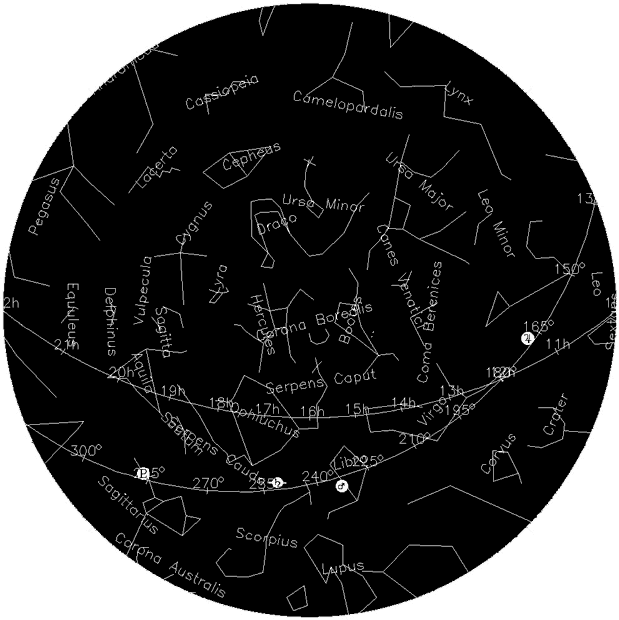NIGHT SKY HAPPENINGS
Moab
UT (at City Hall)
38O34’ N Latitude 109O33’ W Longitude
4048 ft - 1234 m |
The Sky for July 2016
By Faylene
Roth
Sunrise-Sunset
for July
(The time of sunrise and sunset assumes a flat horizon. Actual time may vary depending upon the landscape.) |
DATE |
SUNRISE |
SUNSET |
1 |
5:58am |
8:46pm |
2 |
5:58am |
8:46pm |
3 |
5:59am |
8:46pm |
4* |
5:59am |
8:46pm |
5 |
6:00am |
8:46pm |
6 |
6:01am |
8:45pm |
7 |
6:01am |
8:45pm |
8 |
6:02am |
8:45pm |
9 |
6:02am |
8:44pm |
10 |
6:03am |
8:44pm |
11 |
6:04am |
8:44pm |
12 |
6:04am |
8:43pm |
13 |
6:05am |
8:43pm |
14 |
6:06am |
8:42pm |
15 |
6:07am |
8:42pm |
16 |
6:07am |
8:41pm |
17 |
6:08am |
8:40pm |
18 |
6:09am |
8:40pm |
19 |
6:10am |
8:39pm |
20 |
6:10am |
8:38pm |
21 |
6:11am |
8:38pm |
22 |
6:12am |
8:37pm |
23 |
6:13am |
8:36pm |
24 |
6:14am |
8:35pm |
25 |
6:14am |
8:34pm |
26 |
6:15am |
8:34pm |
27 |
6:16am |
8:33pm |
28 |
6:17am |
8:32pm |
29 |
6:18am |
8:31pm |
30 |
6:19am |
8:30pm |
31 |
6:20am |
8:29pm |
|
The Milky Way runs north to south across the eastern sky from Cassiopeia through Cepheus, Cygnus, Aquila, and Sagittarius. It then spreads westward across Scorpius to fill the southern sky. The Big Dipper (Ursa Major)—which dangles from its handle in the northwestern sky—faces Cassiopeia and Cepheus on the opposite side of Polaris, the North Star. Follow the arc of the Dipper’s handle to orange-tinged Arcturus (Boötes) and continue the arc to blue star Spica (Virgo). Trace the meridian line from north to south beginning with the Little Dipper (Ursa Minor) suspended above the North Star. Move your eyes southward through the head and neck of Draco (between Vega—in Lyra—and Arcturus) then on to the faint trapezoidal body of Hercules overhead (with the Corona Borealis to the west) and over the celestial equator to the large bag-like body of Ophiuchus, the Serpent Bearer. The head of the snake wends westward and its tail trails eastward. Finally, let your eyes settle on Scorpius studded with Mars to the west and Saturn to the east of its head. Follow the scorpion’s tail eastward toward Sagittarius and let your mind and imagination fathom the central depths of our galaxy.
Twilight extends the period of daylight in three stages at each end of the day. Morning twilight begins with astronomical twilight—about 1-1/2 hours (nearly 2 during summer months) before sunrise—as the eastern horizon brightens. Nautical twilight continues—as the overhead sky turns blue and color returns to the surrounding landscape—for another 30-40 minutes. The final stage—civil twilight—provides adequate light for most outdoor activities for the half hour before the sun crests the horizon. The opposite progression occurs after sunset.
VISIBLE PLANETS
Evening (Before Midnight)
Mars –Its red disc appears overhead—west of Scorpius—as nautical twilight fades to astronomical twilight. Mars pairs with red star Antares (15 ̊ eastward). It fades in brilliance (magnitude -1.2) as it moves away from opposition and sets during the middle of the night.
Saturn – Its golden orb (magnitude +1.0)—east of the head of Scorpius and about 15 ̊ east of Mars but above Antares—forms a triangle with Mars and Antares. Saturn sets before dawn.
Jupiter – By evening twilight Jupiter (magnitude -1.7) appears low on the western horizon below the tail of Leo the Lion. It lies on the ecliptic with Regulus (Leo), Spica, Mars, and Saturn. Jupiter sets before midnight as the month begins and drops below the horizon earlier each night. By month’s end it sets as twilight fades from the night sky.
MOON HAPPENINGS
July 4 – New moon (5:01pm) provides dark skies for several nights.
July 11 – Waxing first quarter moon lights the evening sky then sets soon after midnight.
July 19 – Full moon (4:56pm) rises at 8:25pm
July 26 – Dark evening skies return with the waning last quarter moon rising after midnight.
| MAJOR METEOR EVENTS |
Shower |
Peak
(April) |
Range
(April) |
Constellation Radiant |
Rate
(/hr) |
Details |
Conditions
(After Midnight) |
Alpha Capricornids
|
27-29 |
21-31 |
Capricornus |
5 |
Fireballs common
|
Waxing moon after midnight |
Delta Aquarids |
28/29 |
21-31 |
Aquarius |
16 |
Faint meteors on southern horizon |
Waxing moon after midnight |
| Best time to view any meteor event is between midnight and morning twilight when the radiant is overhead. |
Trace the path of any meteor backwards through the sky to reach its radiant--the region of the sky from which meteors appear to originate. |
Primary Sources: USGS; U.S. Naval Observatory; Your Sky at http://www.fourmilab.ch/yoursky/
To find out when the space shuttle and International Space Station are visible from your location,
go to: http://spaceflight.nasa.gov/realdata/sightings/index.html and click on Sighting Opportunities.
The star chart approximates the sky from astronomical twilight to midnight. As the night and month progresses, the constellations shift toward the northwest. The celestial equator is measured in hours (h).
The ecliptic is measured in degrees
Note: Hold your hand at arm’s length to measure apparent distances in the sky. The width of the little finger approximates 1.5̊. Middle, ring, and little finger touching represent about 5̊. The width of a fist is about 10̊. The fist with the thumb extended at a right angle equals 15̊. The hand stretched from thumb to little finger approximates 20̊-25̊. The diameter of both the full moon and the sun spans only 0.5̊. Adjust for the size of your hand.
|
